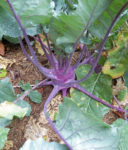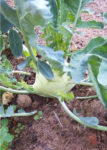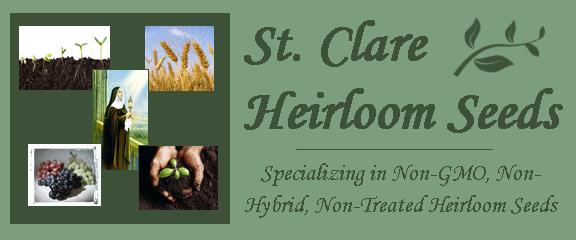Kohlrabi Seeds
Scroll down to see seeds for sale!
Resembling a root, kohlrabi is actually part of the cabbage family and originated from somewhere around Germany through selective breeding of the wild mustard plant. The name comes from two German words “kohl’ for cabbage, and “rube” for turnip, referring to the the similarity in taste with turnips. This odd-looking vegetable made its way to the US in the 1800s, but is still relatively unknown.
Kohlrabi has round stems reaching 6 to 18 inches in height, and large leaves that can be eaten sauteed or steamed. Best picked young, kohlrabi is juicy and crisp, and tastes both slightly sweet and spicy. Don’t wait too long to pick adult plants, as kohlrabi taste woody and unappetizing if too mature. Eaten raw in salads, kohlrabi can be mashed with cauliflower, blended in soups, whipped into frittatas, and even stuffed into calzones. Roasting will caramelize and sweeten this tasty vegetable for side dishes.
An excellent source vitamins C and B, kohlrabi is loaded with minerals such as copper, thiamine, phosphorus, calcium, potassium and magnesium. The high phytochemical content of kohlrabi helps to maintain proper cholesterol levels, improve liver and kidney function, and reduces risk of cancer and diabetes.
Kohlrabi seeds prefer cooler weather, and can be planted twice, in the spring, after chance of frost and in the fall, as long as there is no chance of frost. Be sure and plant your St. Clare Heirloom kohlrabi seeds in full sunlight and be ready to harvest them after about 60 days.
Showing all 2 results
-

Kohlrabi – Early Purple Vienna
$2.59 View ProductAdd to cart(Brassica oleracea) 60 days. Early Purple Vienna Open Pollinated Kohlrabi have bulbs that are reddish purple with tender white flesh. Use Early Purple Vienna when bulbs are 2″ to 2.5″ in diameter.
250 Seeds per pack
-

Kohlrabi – Early White Vienna
$2.59 View ProductAdd to cart(Brassica oleracea) 56 days. Early White Vienna Open Pollinated Kohlrabi bulbs have pale green skin with white flesh. Early White Vienna is very popular.
250 Seeds per pack
Showing all 2 results

